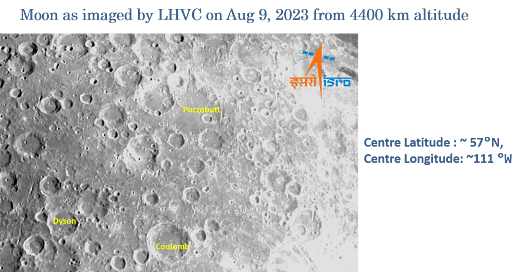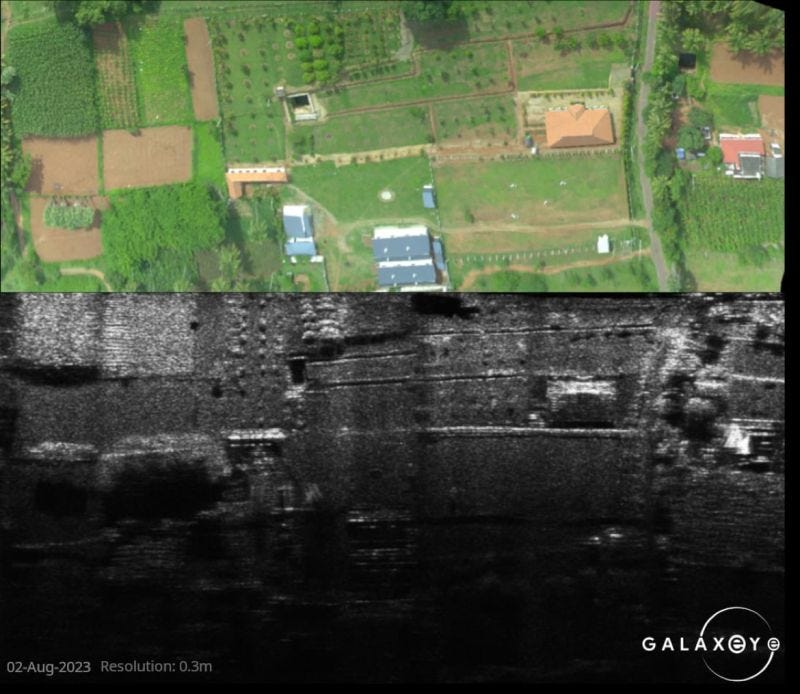Pradeep's Space Newsletter #55
Chandrayaan 3 updates, Opportunity to build a module with the Russian Orbiting Station, and more updates
Chandrayaan 3
Lunar Orbit Insertion (LOI) - 5 August 2023 - 164 km x 18,074 km
Moon Based Maneuver - 6 August 2023 - 170 km x 4,313 km
Moon Based Maneuver - 9 August 2023 - 174 km x 1,437 km
Orbit Circularization Phase - 14 August 2023 - 151 km x 179 km
Orbit Circularization Phase - 16 August 2023 - 153 km x 163 km
The next step is the separation of the lander and rover from the Propulsion Module that was used to make the maneuvers till date. The lander and rover will then make India’s second landing attempt on 23 August 2023.
ISRO’s Chandrayaan 3 update page has more details.
Image Courtesy: ISRO
With the launch of Russia’s Luna 25 on August 11 and reaching on the Moon before Chandrayaan 3, media has been speculating wildly that Russia is in a mini space-race with India. Jatan Mehta has a great explanation on why this is not a race.
ISRO Updates
ISRO conducts drogue parachute test for the Gaganyaan Mission
These drogue parachutes are used to stabilize the Crew Module during its descent and reduce the speed to a safe speed for landing of the Crew Module. The test was conducted at the Rail Track Rocket Sled (RTRS) facility of the Terminal Ballistics Research Laboratory of DRDO at Chandigarh on August 8-10, 2023. These parachutes will be used in the Test Vehicle - D1 flight of Gaganyaan.
ISRO publishes an assessment of the current space situation around the Moon
Chandrayaan 2 had previously performed three collision avoidance maneuvers in 2023. As the lunar orbit gets crowded with current and defunct spacecraft understanding the space situation in lunar orbit becomes important. This is an important contribution towards understanding the same.
De-orbiting PS4 stage in PSLV-C56 Mission
ISRO fired the Orbit Change Thrusters on the fourth stage (PS4) of the PSLV-C56 mission twice to move the stage from a 536 km circular orbit to a 300 km circular orbit. It also carried out passivation of the stage by venting out any gases from pressurized compartments so that they do not pose a threat to any other space bodies.
NSIL Transfers IMS-1 Technology to Dhruva Space
IMS-1 technology has been transferred to Adani-backed Alpha Design Technologies before. The same has also been transferred to Dhruva Space. The release from NSIL notes:
IMS-1, weighing about 100 kg can accommodate a 30 kg payload. Solar arrays generate 330 W power with a raw bus voltage of 30-42 V. It offers a 3-axis stabilization with four reaction wheels with a 1 N thruster that provides +/- 0.1 degree pointing accuracy. IMS-1 bus was utilised in previous ISRO missions like IMS-1, Youthsat and Microsat-2D.
GSAT-24 commissioned for use by Tata Play DTH
After the space reforms, ISRO moved to a demand-driven mode of communications satellite production. Tata Play had procured the GSAT-24 satellite for its DTH services. Launched in June 2022, the satellite was successfully commissioned for use by Tata Play.
Aditya L1 arrives at SDSC-SHAR
ISRO has become active on Instagram. They have shared the news there about the arrival of Aditya L1, India’s dedicated mission to study the Sun has arrived at the Satish Dhawan Space Center for launch on-board the PSLV-C57 mission.
Blog Updates
These are rough drafts of various ideas that I have that could find their way to this newsletter someday.
Private NewSpace in India
Suyash Singh of GalaxEye announced on LinkedIn that they have built a drone based Synthetic Aperture Radar (SAR), called DroneSAR, as a tech demonstrator before flying the SAR on a satellite. He shared the image above in the post.
How Python is used in Space Applications?
Arjit Saxena of Resolute Labs shared his article on how Python is used in space applications.
SatSure makes a strategic investment in Astrogate Labs
The collaboration with Astrogate Labs will unlock potential for KaleidEO's upcoming mission, featuring a fleet of four optical microsatellites with a swath of 65 km and near-meter ground resolution. Astrogate's solution in data transfer will enable seamless and high-speed communication between the satellite fleet and the ground station. Astrogate's terminal will be integrated with KaleidEO's optical payload in its upcoming mission to further enhance the efficiency and performance of the mission.
Newsletters
SatSure Insights: Floods, crop damage and lending dilemma: The impact of floods in Haryana
Unified Heavens: Global Space Law and Policy Newsletter 9 August 2023
Videos
Podcast
Kepler Aerospace aims to be a leader in small satellite development in the defense segment
Before you leave…
There was a news story that Russia has invited the BRICS countries to contribute a module to the Russian Orbital Station (ROS).
The first Indian in space, Wing Commander Rakesh Sharma flew in the Salyut spacestation of the Soviet era. India did not take advantage of flying in Mir. India has the opportunity to fly an astronaut to the International Space Station (ISS) at the behest of the United States of America next year, where Russia is a collaborator.
Russia has contributed to the training of astronauts in the Gaganyaan mission. The Space Roadmap 2047 envisages an Indian Space Station. They also expect to do space station based R&D and pursue economic activities there.Learning to build and fly modules would be useful knowledge to have at that stage.
I think this would be a wonderful learning opportunity for India to grab. I don’t think India’s signing of the Artemis Accords with the United States must stop India from pursuing this opportunity.




